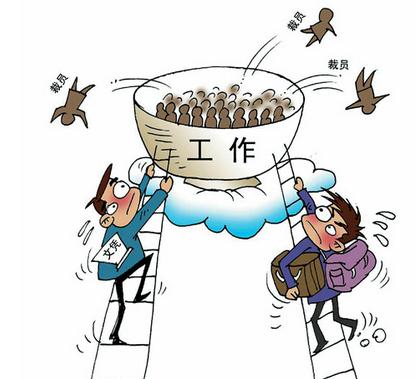As many state-owned companies are afflicted with debt accumulation and production overcapacity, the supply side reform has been introduced to revitalise state-owned companies. However, supply side reform means cutting old-fashioned jobs and eliminating outdated productions, which has revived the painful scourge brought to millions of unemployed people during the first wave of massive layoffs in the 1990s.
Concerns about the arrival of the second wave of massive layoffs are becoming too prevailing to ignore thanks to the momentum-gaining supply side reform. Two recently cogent examples are: over half of the 80,000 steel workers of Wuhan Steel Group, one of China’s biggest steel corporations, will have to leave their steel manufacturing positions this year, and Longmay Mining Holding Company, the biggest state-owned firm in Heilongjiang province, had cut nearly 22,500 coal workers and rearranged them to work in other sectors.
Before the Two Sessions, the second wave of massive layoffs has become a buzzword, and economic analysts predict the supply side reform in industries like steel and coal, which will result in 1.8 million unemployed people, according to governmentally disclosed data, has actually raised the curtain of a new round of massive layoffs.
However, given Chinese economy strength is much stronger than before and the central government, prior to the launch of supply side reform, has woven a comprehensive safety net for workers, whose employment will be affected by the reform, massive layoffs won’t reoccur in China.
The so-called second wave of massive layoffs is a conception vis-a-visa the first wave of laid-offs, when lots of workers in the 1990s, either chose to be resign for the sake of alleviating their corporations’ reform burden, or were forced to be unemployed because of the privatisation of their firms, which almost covered their lifetime expenses of all kinds. The scourge brought by the first wave of layoffs, with lots of unemployed people still living a hard life, not only has been deeply remembered but also silently withstood as the cost for carrying out economic reform.
Nevertheless, different from two decades ago when many jobs were cut ruthlessly, the supply side reform won’t reach its purpose sheerly by throwing away any workers as nonentities who have sacrificed to build a stronger economy. Instead, the government has introduced a comprehensive contingency plan to prevent massive layoffs from reoccurring.
For one thing, the government is trying to create more jobs by transforming economic structure, introducing jobs of new types and developing the third industry. Again, take Wuhan Steel Group for example. Actually, none of its workers will be thrown away: these closing to retirement age can choose to retire with a decent pension, these interested in doing non-steel positions can be rearranged to other jobs within the same group and these who can’t be covered by the first two methods can choose new jobs recommended or provided by government agencies.
For another, for people who have just lost their jobs but can’t land jobs in the short term, the government has allocated special finance fund to subsidise them and offered them useful jobs information. Chinese Premier Li Keying reiterated explicitly in the Government Work Report this year that the central government will appropriate 100 billion yuan to subsidise workers who are laid off due to the clearing of “zombie” companies, which are debt-laden, feeble in market competition but have easy access to governmental subsidies and bank loans.
This contingency plan tries to minimise the number of laid-offs, reduce economic loses of the jobless group to the most extent, and soothe their psychological pain. Backed by the plan, Xu Shaoshi, director of National Development and Reform Committee, confidently stated in a press briefing during Two Sessions that the second wave of layoffs won’t definitely reappear in China.
The clear messages revealed by Premier Li’s and Director Xu ’s remarks show the government’s confidence and determination in preventing the second wave of layoffs from happening. That is, China can consume the layoffs in spite of a slower economy, and the government can offer them equivalent, if not better, alternatives.
The clear messages as well show the government’s unwavering pursuit of emphasising more on social equity and justice. The central government firmly believes economic development fruits should be commonly shared by the people, and layoffs are no exceptional, based on which common sense of supporting deeper reform is shaped. Actually, respecting and protecting legal interests of the laid-off, to a large extent, decides their altitude toward the supply side reform, which in turn will affect the direction of the deep reform.
Time has come to a similar turning point. As 20 years ago China needed to increase the efficiency of state-owned companies, the underway supply side reform is to increase dynamic of state-owned companies. By introducing a comprehensive contingency plan, the government has the ability to prevent large-scaled wave of layoffs from reappearing, and the good result will be: all workers will be united, mobilised and activated to build a better future.








Comment